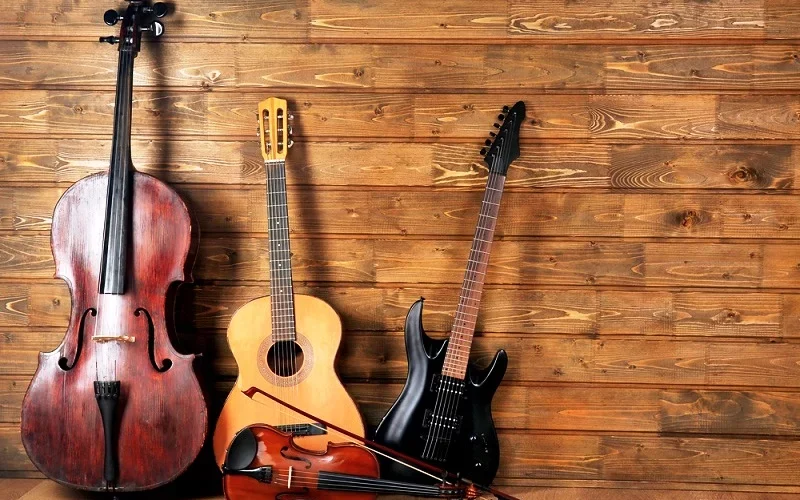There is various kind of instrument all over the world. But we all know that the string instrument is one of the most popular types of instrument. String instruments are usually in line with instruments with keys or drums for a beginner to learn to play music.
The basic definition of a string instrument or the basic working would be providing sound through the vibration made by strings on the instrument when plucked or strummed.
Now let’s introduce you to some of the most popular string instruments in detail:
Structure of String Instruments
There are certain rules that need to be in place for us to call an instrument a ‘stringed instrument’ – some compulsory structure to call it string instruments.
Most of the stringed instruments have a head-first, then there is a neck. After that, there is a hole in most of the string instruments that help to make the sound.
Most string instruments have a wooden body, some have metal or mixed elements. There have strings on the neck. Strings are made of nylon or steel materials.
They’re played using your arms and fingers and most of them are played by plucking/ strumming the strings. Now that we have the basics out of the way, let’s dive into the specific instruments!
How Many Types of String Instruments are There?
The number of family members under string instruments is quite large than any other type of instrument family. This is because stringed instruments come in all shapes and sizes, from the large and imposing double bass to the smaller and most delicate mandolin.
There are more than 300 members of the traditional string instrument family. Since string instruments were born in different parts of the world at various times and cultures, there is a wide range of string instruments available today.
Broadly, different types of string instruments can be classified into four categories:
Bowed strings: The player creates the sound by drawing a bow across the string. Examples of modern bowed string instruments are violin, viola, cello, and double bass.
Plucked strings: The player produces sound by plucking the string with their fingers or a pick. Examples of plucked string instruments are the Guitar, Banjo, Mandolin, and Ukulele.
Struck strings: The player creates the sound by striking the string with a hard object. Examples of such instruments are the Piano, Celesta, and Glockenspiel.
Hammered strings: The player creates the sound by striking the string with a hammer or beater. Examples of hammered instruments are Hammered Dulcimer and Cimbalom.
Most Popular Types of String Instruments
1. Guitar
It’s the most popular form of a stringed instrument to the point that it is probably used in your favorite song.
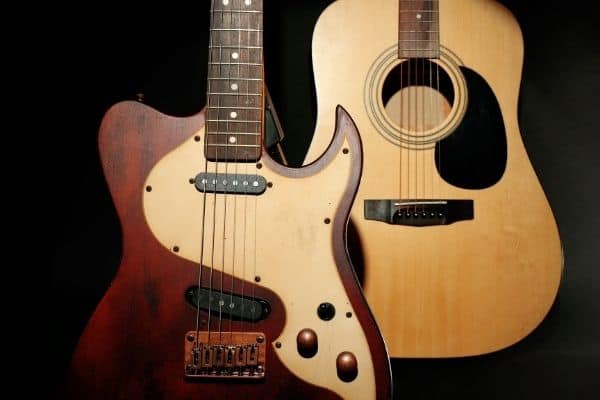
The guitar comes in acoustic and electric varieties, and in most cases, it features 6 strings (there are other types of guitars that feature 7 & 8 strings, but those are for intermediate or professional string instrument players).
It is most known in popular culture as the principal instrument in the musical genres of blues, country, jazz, pop, and rock. The guitar is widespread in today’s popular music scene, and its dominance in popular culture since the 1950s has been the highest.
Acoustic Guitar:
Acoustic guitars are the most popular and commonly seen string instruments. They have hollow bodies, and their strings are made of steel or nylon. The sound is produced from string vibration and amplified by the hollow body.
Acoustic guitars are used in various genres of music such as country, folk, rock, and pop and can be played solo or in a band setting. The nylon-stringed acoustic guitar is also known as a classical guitar.
Electric Guitar:
Electric guitars are similar to acoustic guitars, but they are electronically amplified instruments with a solid body, and their strings are made of metal. An electric guitar is known for its distinct, bright sound.
In the case of electric guitar, the strings vibrate to produce sound and amplify it through an amplifier. These steel stringed instruments are typically played in a band setting accompanied by other musical instruments such as drums and bass.
2. Bass guitar
The bass guitar is usually a little bigger than an electric or acoustic guitar. It has four strings and is remarkably similar to the guitar, and just like the guitar, you get a different type of bass guitar. The exception with the bass is that its notes are roughly an octave lower.
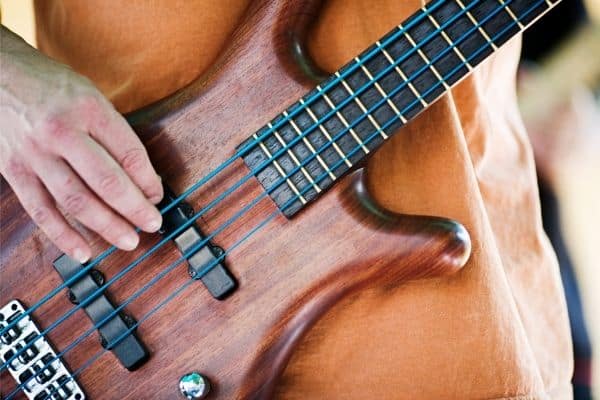
As a result, it is commonly used as a supporting instrument in bands. The bass serves as an excellent foundation for the guitar. The bass and the drums go hand-in-hand and complement each other when in action.
Because of the bass’s size, it may be difficult for younger children to grip and play (the strings are also thicker, making it more difficult to push down) – at least until they become older. For novices, the guitar may be a better alternative.
Also Read: Electric-Acoustic Bass Guitar Review
3. Banjo
Banjo is another one of the stringed instruments that is most commonly heard in bluegrass and country-western music. It has 4 to 5 strings typically but in some cases, the number of strings can go up to 6 as well.
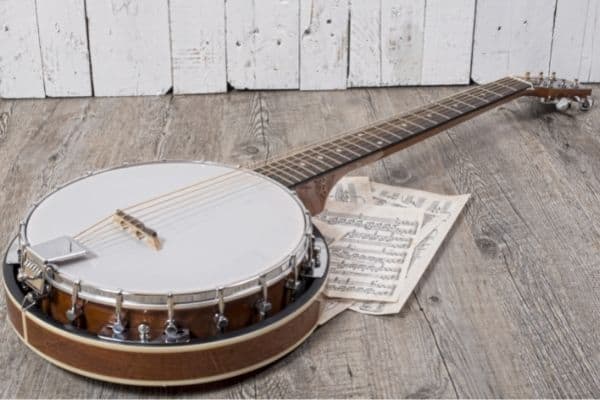
The instrument has a body that is rounded and a long and thin neck. The sound of a banjo is very distinct and unique to this instrument. Compared to a guitar, the body of a banjo is smaller, and instead of an all-wooden body, the banjo is made out of vellum, plastic, or skin.
Banjos are usually amplified with a microphone when performing live, although electronic pickups can also be fitted.
4. Ukulele
The ukulele, nicknamed the ‘uke’, is a four-stringed musical instrument that looks like a tiny classical acoustic guitar and is made of wood.
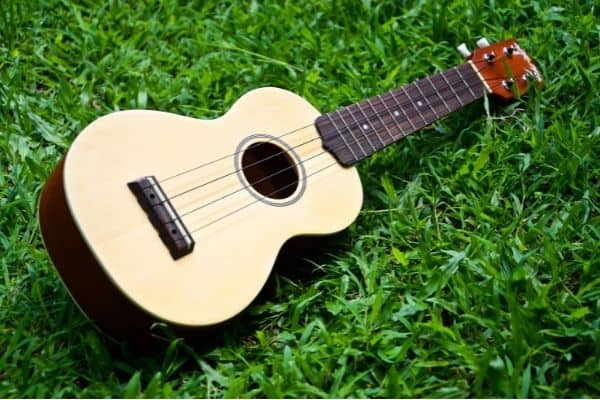
The ukulele is a basic instrument that can create happy-sounding music that is loved all around the world. The ukulele is a widely known string instrument like the others on this list that belongs to the lute family.
Typically, it has four strings, but can sometimes have six or eight. The tone of a ukulele is determined by its size and manufacture, and just like a guitar type, it is available in four sizes: concert, tenor, soprano, and baritone.
5. Mandolin
The mandolin is another of the lute family’s musical instruments. It usually contains 4 courses of doubled metal strings, which means it has 8 strings in totality.
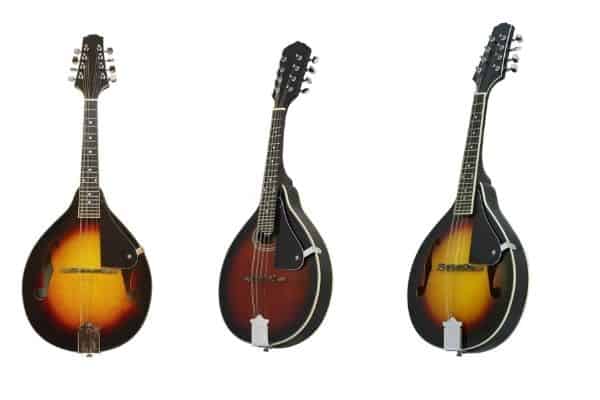
You may have seen someone playing what seems to be a miniature guitar if you’ve ever watched a country music band perform live – chances are that that instrument’s a mandolin.
The carved top has a shallower, arched back and top than the round back, which has a deep bottom. The flat-backed mandolin is comparable to an acoustic guitar in construction.
String Instruments from the West
From the Medieval and Renaissance era to the present day, string instruments have been some of the most popular types of instruments in the Western world. Here is a list of the string-related instruments that were either born in the west or designated as a part of western classical music.
- Violin, Viola, Cello, Double Bass, Guitar, Banjo, Mandolin, Harpsichord, Zither, Lute, etc.
String Instruments from the East
The string instrument has a long and rich history in the eastern world, with many different types of instruments evolved. The sound of eastern string family instruments can be soothing and relaxing or fast and upbeat. One of the significant differences between the eastern and western string instruments is the tuning system.
Out of many, here are some string family instruments from the east:
- Sitar, Sarod, Tabla, Tanpura, Shehnai, Sarangi, Bansuri, Shamisen, Koto, Erhu, Rebab, Zhonghu, Gaohu, Banhu, Jinghu, Liuqin, Pipa, Sanxian, Ruan, Yayli tanbur, Ikatze, Byzantine Lyra, and Morin khuur, etc.
Characteristics of String Instrument
- String instruments are easy to play for any tune. It doesn’t need any keynotes.
- There is no limitation when it comes to the pitch, it depends on the player’s limitation. Any player can create something new and amazing in every step.
- Playing string instruments depends a lot on the strength of health. By that, I mean the strength of a player’s arms or fingers.
- The player can become intermediate or professional through regular practice.
- String instruments provide darker and warmer sounds in the low range but brighter and brilliant sounds in the high range. Range plays a vital role in a string instrument.
- The string instrument must be tuned in the gap of certain time frames.
How do String Instruments Work & Produce Sound?
We have seen string instruments come in all shapes and sizes, from small handheld instruments to large floor-standing musical instruments. But how do they work?
All string instruments commonly work on the same basic principle. The string is plucked or strummed, causing it to vibrate. This vibration is then enhanced by the instrument’s body before being projected out as sound.
Different string instruments work in different ways to achieve this. For example, the violin uses a bow to make the string vibrate, while the guitar uses the player’s fingers (or a pick) to do so. The type of material the string is made from also affects the sound it produces – for example, metal strings will create a brighter, sharper sound than nylon strings.
The string’s length also affects the sound it produces. An instrument string that has stretched further will vibrate more slowly than a string that is under less tension and will create a lower note. This is why string instruments are often tuned – by tightening or loosening the strings. The player can raise or lower the string’s pitch to create the desired note.
Amplifying the string’s vibration is most commonly done using a resonating chamber. For example, the violin has a hollow body that amplifies the string’s vibrations, while the guitar has a solid body with a hole in the middle (the sound hole) that amplifies the string’s vibrations.
Once the string’s vibration has been amplified, it is thrown out as sound through the instrument’s soundboard. The soundboard is a thin piece of wood that vibrates along with the string, helping to project the string’s sound outwards. So, that’s how string instruments produce sound!
Playing Methods of a String Instrument
There are numerous ways in which you can play a string instrument but I’m going to mention the top 3 most used ways of making the instrument audible. Keep reading to learn more:
Bowing
Bowing is a method that is played using a bow and not hands. Hands are only used to control the movement of the bow across the instruments. It is slid across the strings of the instrument for creating vibrations and to make the instrument audible.
It’s used in instruments like violin, viola, cello, and other instruments in an orchestra. Typically, it takes a little time to get used to the bow.
Plucking
Plucking is also another method of playing string instruments. Plucked instruments like ukelele, guitar, mandolin, banjo, and other members of the lute family – all can be played by plucking using a finger or thumb.
A plastic plectrum is also available to pluck strings and it’s most commonly used with a guitar.
Striking
Strike the string is the third common method of sound production in string instruments. Many instruments (the most common example is a bass guitar) are played by hitting the strings into vibrational movement.
Bowed instruments can also be played with a strike, thanks to a bowing method known as col legno, which uses the rear of the bow as the striker.
Final Words
And that brings us to the end, I hope you all know much more about the string family after carefully going through this article. These are just the most common string instruments but you can find a ton of unique instruments if you go by genre.
If you’re a beginner looking for your first instrument, my recommendation would be either a guitar or a bass. Either way, you can’t go wrong because they’ll help you get the foundation just right for playing a string instrument. All the best for your musical journey!

